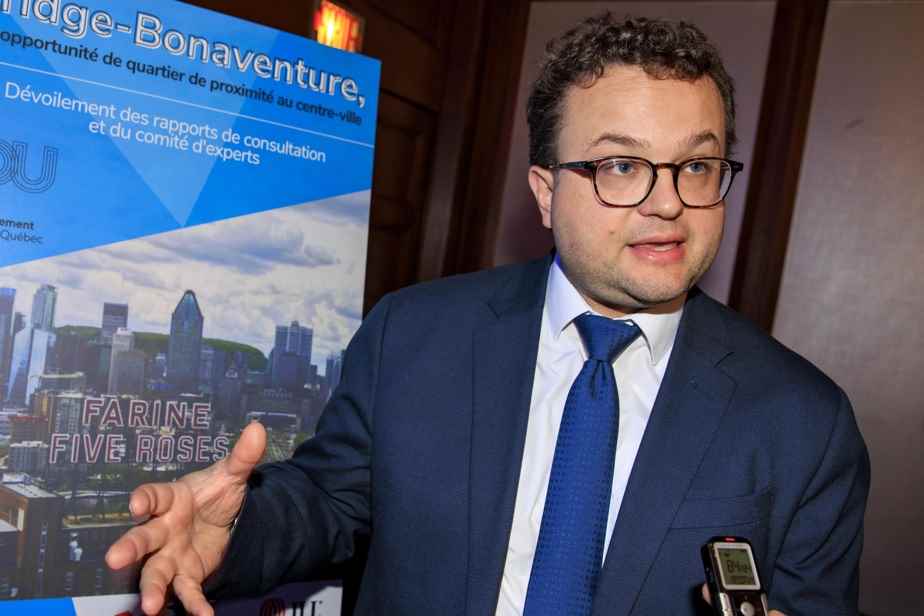The Bridge-Bonaventure district, at the southwest entrance to downtown Montreal, lends itself well to the construction of high-density housing, according to a report by three university experts commissioned by the Urban Development Institute of Quebec (IDU), real estate industry lobby.
Posted at 2:50 p.m.
This devitalized industrial district is the subject of a tussle between the City of Montreal and developers regarding its future redevelopment in a context of housing shortage, especially affordable housing.
The question of density is at the heart of the divergence in the visions of the City and that of developers. The latter, grouped within the Vision Bridge-Bonaventure consortium, propose to build 7,500 housing units in the area, including 3,600 affordable and social housing units. The City suggests 3,800 housing units in total in its preliminary vision unveiled in March.
In the experts’ report unveiled on Tuesday, at least 5 of the report’s 30 recommendations go in the direction of support “for the development of a high-density residential offer”. The presentation of the conclusions was made by Jean-Marc Fournier, CEO of the IDU, during a lunch-conference.
Its authors are Jean-Philippe Meloche, professor and director of the School of Urban Planning and Landscape Architecture at the University of Montreal, Ursula Eicker, holder of the Chair of Excellence in Smart Cities at Concordia University and Pierre Barrieau, co-founder of Gris Orange Consultant and lecturer in transportation planning at the University of Montreal.
The introduction of a new mass of housing makes it possible to alleviate the pressures on the rents of the existing housing stock. On the other hand, in areas that are heavily regulated in order to limit the size of authorized new developments, an increase in financial pressure on the housing stock is inevitable.
Opinion of the three university experts; Bridge-Bonventure Sector
The goal is to authorize high-rise buildings to free up ground space to make green spaces and other community or civic vocations.
“In this sector, there is potential for density,” explained Mr. Meloche, in an interview that followed lunch. It is a neighborhood close to the city center, the probability of having pedestrians, cyclists and public transport users is higher than in more distant areas. We don’t have many good reasons to limit the density of this neighborhood. »

PHOTO ALAIN ROBERGE, THE PRESS
Jean-Philippe Meloche, Professor and Director of the School of Urban Planning and Landscape Architecture at the University of Montreal
The report does not define what it means by high density. “The idea is to have a few buildings that would be bigger, stronger, that would mark the landscape and then have modulations from below,” explained Pierre Barrieau. We are talking about densities that are higher than what the City is proposing. »
The experts also propose the creation of an organization on the model of the organization Quartier international de Montréal, a non-profit organization headed by Clément Demers who oversaw the redevelopment of the district surrounding the convention center. He would be responsible for coordinating the redevelopment of the area.
Openness with respect to density
The Vision Bridge-Bonaventure consortium took advantage of the event to unveil the results of a consultation of 19 organizations on its vision for the neighbourhood. “There is a lot more openness on the questions of density, heights, ground occupation [que par le passé] summarized Arnold Beaudin, one of the two facilitators responsible for carrying out the consultation of organizations.
Note that two elected members of Mayor Valérie Plante’s team attended the event. “We’ll take it all. We will analyze it, also evaluate it,” said Robert Beaudry, member of the executive committee of the City of Montreal, who repeated the promise to make public the preliminary master plan for the Bridge-Bonaventure sector before the end of the year, plan that will be submitted to the Office de consultation publique de Montréal.
” It’s necessary [le futur plan directeur] be precise and concrete with quantitative scales and that it specifies the regulatory tool that the City will use to rezone the entire sector,” said Serge Goulet, president of Groupe Devimco, one of the largest landowners in the district.

